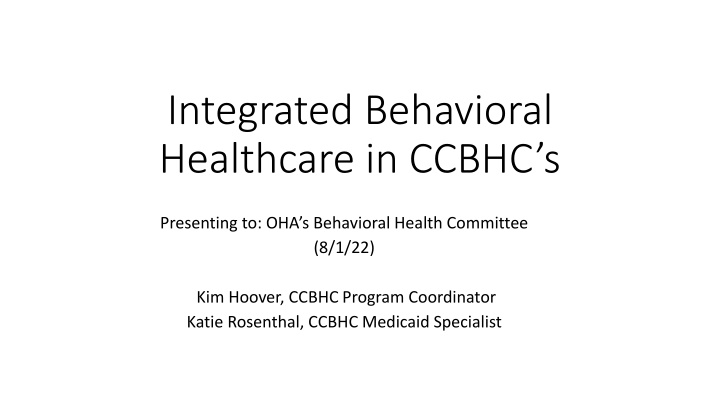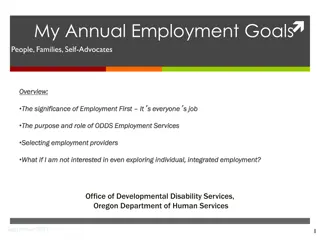
Integrated Behavioral Healthcare in Certified Community Behavioral Health Clinic
Explore the evolution of integrated behavioral healthcare in the US, from traditional indigenous practices to the modern-day challenges and opportunities faced by Certified Community Behavioral Health Clinics (CCBHCs). Learn about the cultural contexts shaping healthcare delivery and the importance of integrating mind, body, and spirit in holistic patient care.
Download Presentation

Please find below an Image/Link to download the presentation.
The content on the website is provided AS IS for your information and personal use only. It may not be sold, licensed, or shared on other websites without obtaining consent from the author. If you encounter any issues during the download, it is possible that the publisher has removed the file from their server.
You are allowed to download the files provided on this website for personal or commercial use, subject to the condition that they are used lawfully. All files are the property of their respective owners.
The content on the website is provided AS IS for your information and personal use only. It may not be sold, licensed, or shared on other websites without obtaining consent from the author.
E N D
Presentation Transcript
Integrated Behavioral Healthcare in CCBHC s Presenting to: OHA s Behavioral Health Committee (8/1/22) Kim Hoover, CCBHC Program Coordinator Katie Rosenthal, CCBHC Medicaid Specialist
How did we get here? Many global indigenous cultures have philosophies, spiritualities, and/or medicinal practices (some dating thousands of years) which not only view health as whole person (mind, body, soul), but as an extension of the environment. Traditional Chinese Medicine, Naturopathy, Ayurveda, Homeopathy, Yoruban, Maori, and Aymara Traditions, etc. In the US, elite medical schools, corporate sponsors, and national lobbyists (American Medical Association) reformed healthcare policy/licensure in the early 1900 s, making it illegal for especially women and people of color to practice alternative, complementary, and holistic forms of medicine.
How did we get here? contd As medicine became a domain of science in the US, rather than a spirituality or philosophy, medical professionals developed specialized, specific expertise of the physical body OR psychology; women and people of color were excluded from contributing academically for hundreds of years The World Health Organization and the National Institute of Health have public integrative medicine strategies WHO cites integrative medicine as means preserve the intellectual property of culturally-specific medicine NIH does not address cultural appropriation
Why Integrated Behavioral Health in the US? IBH begins to integrate siloed medical knowledge about the mind and body, in addition to spirituality of an individual Rates of depression, anxiety, and substance use continue to climb in the US, and SPMI (severe and persistently ill) populations have increased risk for specific physical conditions like diabetes and hypertension; former models of treating mental health alone is inadequate for these populations Even integrated care in a modern US behavioral health settings can be considered cultural appropriation because biomedicine is now developing sciences to support what other cultures have practiced for thousands of years: whole person health IBH stills needs to integrate with culturally-specific healthcare
Certified Community Behavioral Health Clinics (CCBHC) Oregon is an original grantee of the federal CCBHC demonstration which began in 2017; 12 clinics in 11 counties CCBHC s focus on integrated behavioral healthcare, especially for the SMPI population 9 core services, including SUD, crisis, targeted case management, peer support, psychiatric rehab, MH & PH screening/assessment, patient-centered treatment, veteran services From the first demo year, Oregon has required 20 hours of primary care on site for CCBHC s to enhance integrated care Some variances like co-location or contracted PCP Care coordination is key to integrated model
What the Research Says: CCBHCs have increased access to services: Oregon increase number of clients served with SPMI by 17% from 2016 to 2018- nearly three times the increase in the population served by non-CCBHCs. CCBHCs have expanded access to a variety of services: Oregon saw increase in 21 services including care coordination, veteran s services, services for older adults, primary care, outpatient mental health and substance use disorder treatment, MAT, peer delivered services, case management, vocational skills training, wraparound services, assertive community treatment (ACT), jail-based services, jail diversion, home visits, first episode psychosis programs, rehabilitation services, screenings and assessments CCBHCs have expanded the workforce: Oregon saw increase in nurses, qualified mental health professionals, psychiatrists, primary care providers, data analysts and peers within CCBHCs https://www.thenationalcouncil.org/wp-content/uploads/2022/02/Transforming-State-Behavioral- Health-Systems.pdf
Questions? Questions? Thank you.






















